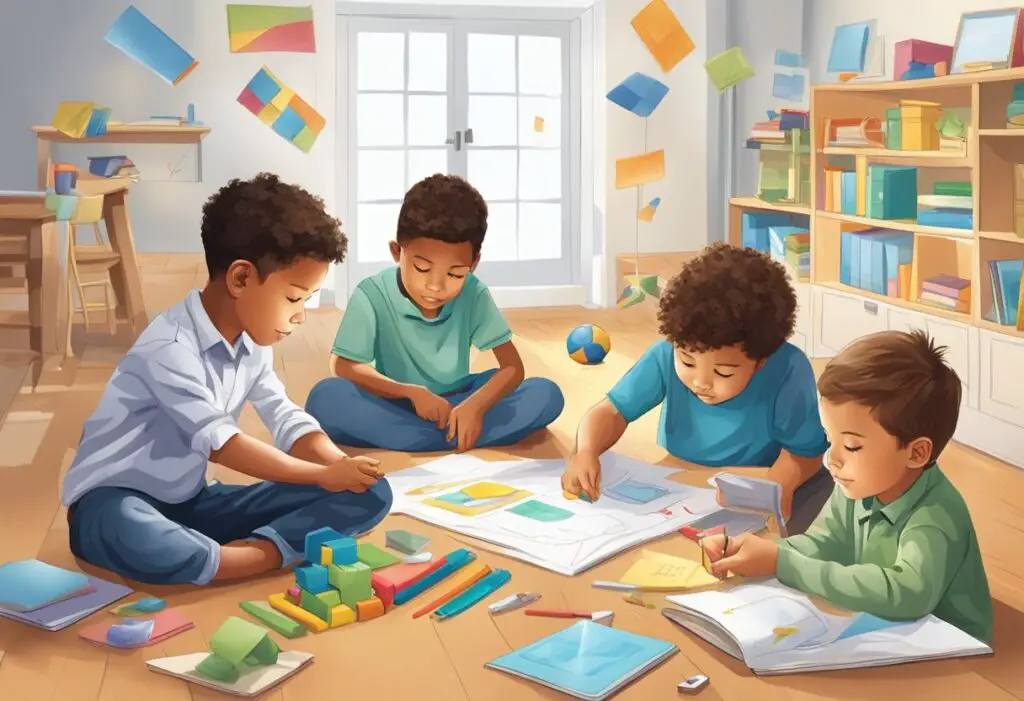So, you want to help your kids develop a growth mindset? Great idea! A growth mindset is the belief that your abilities can be improved through hard work, perseverance, and learning from mistakes.
By encouraging a growth mindset in your kids, you can help them develop a positive attitude toward learning, increase their motivation and resilience, and set them up for success in school and beyond.

But how do you actually foster a growth mindset in your kids? Well, luckily, there are plenty of fun and engaging growth mindset activities that you can try with them. From crafts and coloring pages to escape rooms and fortune tellers, there are endless ways to help your kids develop a growth mindset and have fun at the same time. So, let’s dive in and explore some of the best growth mindset activities for kids!
The Brainy Business of Growth Mindset
Understanding the Growth Mindset
You may have heard of the term “growth mindset” before, but what exactly does it mean? Well, it’s the belief that your abilities can be developed and improved through hard work, dedication, and perseverance. This is in contrast to a fixed mindset, which is the belief that your abilities are predetermined and cannot be changed.
Having a growth mindset can lead to increased motivation, resilience, and a willingness to take on challenges. It can also help children develop a love of learning and a desire to continuously improve themselves.
The Science Behind the Growth Mindset
Believe it or not, there is actually scientific evidence to support the idea of a growth mindset. Research has shown that the brain is capable of changing and growing throughout our lives, a concept known as neuroplasticity. This means that our abilities are not fixed and can be improved with effort and practice.
Neuroplasticity occurs through the growth and strengthening of connections between neurons in the brain. When we learn something new or practice a skill, these connections become stronger and more efficient. This is why it’s important to challenge yourself and push beyond your comfort zone – it helps to create new neural pathways and improve your abilities.
So, the next time you’re feeling discouraged or like you’re not good enough, remember that your brain is capable of amazing things. With a growth mindset and a little bit of effort, you can achieve anything you set your mind to.
-

Bold Male Pride – Baseball Trucker Cap Celebrating Masculinity
£18.00 Select options This product has multiple variants. The options may be chosen on the product page -

Dad Bod Appreciation Gift Mug
£14.00 Add to cart -

Dad Bod, Bad Jokes Structured Baseball Cap
£22.00 Select options This product has multiple variants. The options may be chosen on the product page
Pump Up the Volume: Activities to Foster a Growth Mindset
Encouraging a growth mindset in kids is no easy feat, but with the right activities, it can be a fun and engaging process. Here are some classroom and home activities that will help your kids develop a growth mindset.
Classroom Activities
Anchor Chart
Create an anchor chart that illustrates the difference between a fixed mindset and a growth mindset. Use this chart to teach your students that intelligence and abilities can be developed over time with hard work and dedication. Make it fun by using bright colors and creative illustrations.
Escape Room
Transform your classroom into an escape room and challenge your students to solve puzzles and riddles that require a growth mindset. For example, create a puzzle that requires students to use trial and error to find the right solution. This activity will teach your students that setbacks and failures are a natural part of the learning process.
Coloring Pages
Coloring pages are a great way to help your students relax and focus on positive affirmations. Create coloring pages that feature growth mindset quotes like “I can do hard things” or “Mistakes help me learn.” This activity will help your students develop a growth mindset while also improving their fine motor skills.
Fun Activities at Home
Crafts
Crafts are a great way to keep your kids engaged and learning at home. Create crafts that teach your kids about the growth mindset. For example, create a paper chain that features growth mindset quotes or create a vision board that illustrates your child’s goals and aspirations.
Growth Mindset Escape Room
Create an escape room at home and challenge your kids to solve puzzles and riddles that require a growth mindset. For example, create a puzzle that requires your child to use trial and error to find the right solution. This activity will teach your child that setbacks and failures are a natural part of the learning process.
Coloring Pages
Coloring pages are a great way to help your child relax and focus on positive affirmations. Create coloring pages that feature growth mindset quotes like “I can do hard things” or “Mistakes help me learn.” This activity will help your child develop a growth mindset while also improving their fine motor skills.
With these activities, you can help your kids develop a growth mindset in a fun and engaging way. Remember, it’s not about being perfect; it’s about learning and growing along the way!
The Power of ‘Yet’: Language and Growth Mindset
The Impact of Positive Language
Words have power, and the language we use can have a significant impact on our mindset. Using positive language can help children develop a growth mindset, which is the belief that abilities and understanding can be developed through hard work and dedication.
One way to encourage a growth mindset in children is to use the word “yet.” When a child says, “I can’t do this,” add the word “yet” to the end of the sentence. For example, “I can’t do this math problem yet.” This simple addition changes the sentence from a fixed mindset to a growth mindset and reminds children that they have the potential to learn and grow.
The Role of Affirmations
Affirmations are positive statements that can help children develop a growth mindset. Encourage children to create their own affirmations, such as “I am capable of learning new things” or “I can do hard things.” Write these affirmations down and display them in a prominent place, such as on a bulletin board or on the fridge.
Encourage children to repeat these affirmations to themselves regularly. This can help them develop positive self-talk, which can boost their confidence and help them overcome challenges.
In addition to affirmations, encourage children to focus on positive thoughts. When faced with a challenge, ask them to think of something positive that they have accomplished in the past. This can help them build resilience and develop a growth mindset.
Remember, the language we use and the thoughts we think can have a powerful impact on our mindset. By using positive language and encouraging positive thoughts and self-talk, we can help children develop a growth mindset and reach their full potential.
Bouncing Back: The Role of Resilience and Perseverance
As a parent or teacher, you want your child to succeed in life. However, success is not always a straight path. There will be challenges, setbacks, and obstacles along the way. This is where resilience and perseverance come into play.
Understanding Resilience
Resilience is the ability to bounce back after facing adversity. It is not about being immune to challenges but rather being able to face them head-on and come out stronger on the other side. In fact, research has shown that resilience is a key factor in achieving success.
So, how can you help your child develop resilience? One way is to encourage them to take on challenges and not be afraid of failure. When they face setbacks, help them see it as an opportunity to learn and grow. Teach them to focus on the positive and not dwell on the negative.
Fostering Perseverance
Perseverance is the act of persisting through challenges and obstacles. It is about not giving up when things get tough. Developing perseverance takes time and practice.
One way to foster perseverance is to set goals with your child. Help them break down their goals into smaller, more manageable steps. Celebrate their progress along the way, and encourage them to keep going even when the going gets tough.
Another way to foster perseverance is to teach your child the importance of grit. Grit is the combination of passion and persistence. It is about having a long-term goal and sticking with it, even when it gets difficult.
In conclusion, developing resilience and perseverance is crucial for success in life. By teaching your child to bounce back from challenges and persevere through obstacles, you are setting them up for a bright future. Remember, challenges are opportunities for growth, and with the right mindset, your child can overcome anything that comes their way.
The Art of Failing Successfully: Learning from Mistakes
The Value of Making Mistakes
You might think that making mistakes is a bad thing, but actually, it’s one of the best ways to learn and grow. When you make mistakes, you get the chance to figure out what went wrong and how you can do better next time. This is called a growth mindset. A growth mindset means that you believe your abilities can improve over time with practice and effort.
One way to encourage a growth mindset in kids is to teach them the value of making mistakes. You can do this by creating activities that allow them to experiment and learn from their mistakes. For example, have them try to build a tower out of toothpicks and marshmallows. When the tower falls down, ask them what they learned and how they can make it better next time.
Famous Failures
Did you know that some of the most successful people in the world have failed many times before they achieved their goals? It’s true! For example, Walt Disney was fired from a newspaper because he “lacked imagination and had no good ideas,” and his first animation studio went bankrupt. But he didn’t give up. He kept trying and eventually created Mickey Mouse and Disneyland.
You can use these stories of famous failures to inspire kids to keep trying even when they make mistakes. Create a list of famous people who failed before they succeeded, and talk about how they persevered and learned from their mistakes. This can help kids see that failure is a normal part of the learning process and that success often comes after many mistakes.
Remember, making mistakes is not the end of the world. It’s an opportunity to learn and grow. By teaching kids the value of making mistakes and showing them examples of famous failures, you can help them develop a growth mindset and the resilience they need to succeed in life.
Tools for Growth: Resources and Strategies
Educational Resources
As an educator, you know that nurturing a growth mindset in kids is essential for their success. But where do you start? Lucky for you, there are plenty of resources available to help you out.
One great resource is the article “How to Nurture a Growth Mindset in Kids: 8 Best Activities” by Positive Psychology. This article provides eight effective strategies for fostering a growth mindset in kids. From creating a growth mindset vision board to using positive post-it notes, these activities are sure to inspire your students.
Another fantastic resource is the podcast “The Growth Mindset for Kids” by Big Life Journal. This podcast features interviews with experts in the field of growth mindset and provides practical tips for parents and educators.
If you’re looking for a more comprehensive approach, consider using a growth mindset curriculum like the one offered by Mindset Works. This curriculum is designed to help students develop a growth mindset through interactive lessons and activities.
Effective Strategies
In addition to educational resources, there are also several effective strategies you can use to promote a growth mindset in your students.
One strategy is to focus on effort over ability. Encourage your students to see mistakes and failures as opportunities for growth and learning. Remind them that the brain is like a muscle that gets stronger with exercise.
Another effective strategy is to use positive affirmations. Encourage your students to repeat positive statements like “I can do hard things” or “I am capable of learning new things.” These affirmations can help boost their confidence and self-esteem.
Finally, don’t forget to model a growth mindset yourself. Share stories of your own struggles and how you overcame them. Show your students that it’s okay to make mistakes and that learning is a lifelong process.
With these resources and strategies, you’ll be well on your way to nurturing a growth mindset in your students. So go forth and inspire the next generation of lifelong learners!







